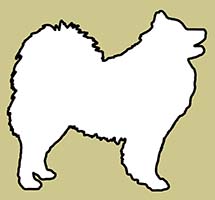Aboriginal Samoyed Dogs of the Yamal Peninsula
by Vladimir Beregovoy
During early part of 20th century, Russians did not pay serious attention to Northern aboriginal dogs of their country. Purebred local sled dogs and any of the mixes with non-aboriginal imports were used for pulling sleds. According to official census conducted in 1926-1927, total number of sled dogs in the entire Arctic region of Russia was 54,483. During those years, an idea about establishing sled pulling and reindeer herding breeds was discussed, but nothing serious had been done in this direction. Communist rulers in Moscow believed enthusiastically in a rapid technological progress to move the country forward into the 20th century. Dogs were considered as a vestige of the past and should be replaced by motor driven vehicles. Therefore, they simply ordered local magistrates to shoot dogs without a delay. In many places across Russian North this was executed in a brutal way. Dogs were tied to poles outside villages and shot. Luckily, they could not accomplish it everywhere primarily because of vastness and lack of accessibility of their northern territories.
After World War II, with the expansion of labor camps and industrial development in the Arctic regions of Russia, the identity of the remaining aboriginal dogs became threatened by influx of European breeds arriving with people. Among the imports, the German Shepherd, various hounds, Irish Setters and Spaniels were the most common. Purebred German Shepherds are poor sled pulling dogs as are the other domesticated breeds brought in. After a day of working in the harness they need a rest for a few days. For imported breeds, the environment is very harsh even in the summer, because of attacks by mosquitoes and black flies. However, mixes of aboriginal dogs with German shepherds and other breeds do well. To some extend, the harshness of life in the tundra serves as a natural protector for aboriginal dogs from genetic contamination.
In June-August, 1961, I traveled with a team of zoologists to the Yamal tundra, where I worked on my postgraduate project in ornithology. We spent about two months in Arctic Ural area and Southern parts of the Yamal Peninsula. I had an excellent opportunity to watch local dogs and ask local people about their dogs. Dogs were a common sight everywhere. Near cities, most of local dogs had traits of certain imported breeds, such as loose lips, lop ears, barrel-like chest, short legs, wavy hair and unusual coat colors. It seemed that people did not care what kind of dogs to harness for pulling sleds. Further from cities, however there were more uniformly Spitz-like medium to large size dogs. Nomadic people who live in this Arctic Ural area and Yamal Peninsula call themselves Nenets. In their language this means simply a human being. In old Russia, these people were called Samoyede (Samoyeds) that in the Russian language means literally self-eaters (cannibals). Because this term sounds derogatory, Russians began calling them “Nentsy”, instead of “Samoyeds”. In the Russian language, the aboriginal dog of the Nentsy is called the Nenets Deer Herding Laika. As we know, in USA and Europe, the term Samoyed stuck with a breed originated from the aboriginal population of dogs of Nenets people. Russians apply term Laika to all northern type dogs with pointed muzzle, prick ear and fuzzy coat. Street mongrels with a similar look would be also called Laika. Laika is a frequent name given to mutts kept as pets. Thus, the first dog sent in Sputnik was a smallish female mutt with partly lop ears was named Laika. Although this dog had nothing in common with any of the aboriginal dogs of Russia, her personal name “Laika” gave reason for erroneous information that Russians used Laikas in their space research programs disseminated in the Internet and in some printed publications.
Description of Aboriginal Dogs of Nentsy.
We saw the most typical aboriginal dogs on the banks of the Poluy River and other places further away from cities.
Appearance. On both banks of the Poluy River, a tributary of the Ob River, almost all dogs look similar to the Samoyed. Most of these dogs have a long coat similar to the Samoyed. However, their size and color of the coat are more variable. The size varies from small to medium and large. Because of the shaggy coat, these dogs seem sturdier than they actually are. They all are lean and light built. The weight range approximately from 30 to 60 pounds.
Coat. The coat consists of long straight and harsh guard hairs and very thick woolly undercoat remaining on the dog even in the summer. Actually, it serves dogs well in winter and summer. The guard hair is harsh and straight and drifting snow does not adhere to it. The coat helps to keep them warm in winter and protects from mosquitoes in the summer. Natives never comb their dogs. In June dogs are shedding heavily. Old and new hair often form mats that are dangling on the dog’s body. Some of mats are permanent and can be removed only by using scissors. In late June, the Yamal tundra looks beautiful. It is green, with yellow Arctic Poppies and scattered patches of still melting snow. However, its serene look is deceptive. This country is teaming with mosquitoes and black flies. At night, temperature may drop close to freezing point so a dog’s warm coat is apparently needed.
There are many dogs with biscuit and white coat color, but white dogs with black patches and entirely black dogs are very frequent. White and biscuit dogs have brown noses.
Head. The head is wedge-shaped and triangular in view from above. In large dogs, the frontal part of the skull is flat or slightly rounded and the muzzle is long and powerful. In large dogs the muzzle is as long as the skull from eye to occiput and it is more full. In smaller dogs the muzzle is shorter than the skull and tends to be somewhat snippy. The skull of smaller dogs is slightly domed.
Teeth. Teeth are large and strong, evenly spaced and with a scissors bite.
Eyes. Eyes are brown, almond-shaped and set oblique.
Ears. Ears are of medium size and always stand upright, if not injured in dogfights. In small dogs ears are proportionally larger and set further apart.
Neck. The neck is strong and of medium length, but it seems short because of the long and thick coat on the neck.
Tail. The tail is carried high curving over the back and lays to either side or over the back. There are dogs with tails curled over the back and sickle shaped.
Body. The body is lean, but muscular. The chest is deep and relatively narrow. The abdomen is medium tuck up. Larger dogs have proportionally longer legs than smaller dogs. In larger dogs, hind legs are well angled at stifles and hocks and, if viewed from behind, slightly cow-hocked. Feet of the aboriginal Samoyeds are neither cat or hare. They are elongate, with long well arched toes and strong hard pads and nails. Actually majority of local dogs we saw has east-west front feet and cow-hocked hind legs.
Breeding. Females come in season two times per year and not fixed with any season. Number of puppies per litter ranges from three to seven. Bitches are excellent mothers. If whelping takes place in spring or summer, they can make their own den for whelping and take care about their puppies without any intervention of people. However, if whelping takes place in middle of winter, the bitch and puppies may be taken inside. Purebred pure aboriginal dogs, if fed quality food, have erect ears before age of eight weeks.
Barking. Aboriginal dogs of Nenets bark very well and often. Barking is heard quite often when dogs are excited, herding deer or treeing small game. They always bark when an unfamiliar person or dog is approaching their home territory.
Way of Life with Nenets People. Near Salekhard and Labytnangy, dogs are seen everywhere. Majority of these dogs are pulling sleds in the winter, but in the summer they are allowed to wander free. They are not fed regularly and always looking for food. They chase anything trying to catch but reindeer. Their typical prey includes lemmings, voles and other rodents. Arctic Fox and Arctic Hare venturing close enough are always chased and sometimes make a meal of by the dogs.
Nenets and Hanty people treat their dogs well. The typical number of dogs per household ranges from one to five. Nenets and Hanty allow their dogs inside their chum (a teepee-like conical house made of wooden poles and deer skins). During meal time dogs form a second circle behind people’s backs. Occasionally, bones or pieces of fish are tossed for the dogs. Dogfights over the food are common even inside the chum, but people just lough and do not intervene. Overnight dogs are allowed to stay inside and sleep with people keeping each other warm.
Nenets highly value their adult dogs, but a puppy can be obtained at no cost or traded for a bottle of vodka.
Diet. Nenets and other natives of this region use their own method of preservation of common white fish (Coregonus sp.) Fresh whole fish, not scaled or skinned, is placed in a pit dug in the permafrost on a layer of sedge. Layers of fish with salt alternated with a layer of sedge grass are placed one upon another until the pit is filled. Once filled, everything is covered with sedge, dirt and ice. Nenets and other natives use very little salt on each fish or do not use it at all. After a prolonged storage, the fish smell does not diminish, it’s odor is still quite strong and the meat easily separates from bones. It is eaten eagerly by both people and dogs. Eating fish prepared by this method takes an acquired taste, but local people and dogs are the best proof that it is nutritious and obviously safe to eat. After all, this tradition is hundreds of years old. In winter and in the summer Nenets and Hanty feed their dogs all table scraps. When dogs are used for work, they are fed reindeer meat, seal or whale meat with blubber and plenty of fish of any kind.
Now, Nenets People are free to continue their life with their dogs and reindeer. I only hope that pure aboriginal type dogs still exist in the Nenets country and Russians already working on establishing the Nenets Deer Herding Laika (Nenetskaya Olenegonnaya Laika).
Relation to Humans. Aboriginal Samoyeds are friendly to people and wag their tails greeting visitors. However, after the first greeting, they stay away from the stranger. Although they are human-friendly dogs, they always bark when unfamiliar people approach their village.
Relation to Animals. Dogs of Nentsy belonging to the same household establish hierarchical relationships and live in piece with each other most of the time. However, they are competitive and small fights for dominance usually occur. Unfamiliar dogs are fought enthusiastically and may be killed, because all the dogs may attack the “intruder” simultaneously.
Aboriginal Samoyeds can be easily trained to live peacefully with farm animals just like they live in piece with domesticated reindeer. However, when new settlers in the Arctic Ural area and Yamal tundra brought goats, cows and cats, these animals were eventually killed by dogs, if left unattended.
Utilization. In the Arctic Ural area, Yamal Peninsula and further to the east longhair aboriginal dogs similar to the Samoyed are used for herding reindeer. When herding, these dogs help to keep deer herd together on the move to better pastures. In winter, dogs help to trail and find lost reindeer. When dogs find stray reindeer far away from people they stay with them for a long time, sometimes even for few days without food guarding the deer. Dogs are barking a lot that helps their master to find where they are. Endurance, courage and determination of these dogs are amazing.
Another common form of using of aboriginal dogs of Nenets people is hunting. When hunting, these dogs act like bark pointers helping to find and tree grouse, squirrel and other small game. Despite the long coat, some of these dogs are trained and work well as duck retrievers. They do not hesitate to swim or wade in water at a subfreezing temperature. I purchased a two year old male who made an excellent hunting dog.
In Arctic Ural area and Yamal tundra, where pastures of lichens for reindeer exist, reindeer is a major draft animal. Further to the north, in Arctic tundra, where reindeer can not survive because of the absence of lichen pastures, these dogs are commonly used to pull sleds.
In winter, aboriginal Samoyeds are often left tied out or guarding reindeer in a bitter cold. These dogs often have to work under the harsh conditions of a blizzard or freezing rain. In the summer their life is hardly easier than in the winter. In June-July, in the Yamal tundra, the mosquito population is at its peak. Here, if one attempts to brush attacking mosquitoes off, they do not even attempt to escape. Simply by pressing a palm against the back of another person’s, we counted all the mosquitoes killed and the numbers ranged from 70 to 80 mosquitoes in a few square inches. Every dog digs an individual hole in the river bank to stick most of his body in it. A breeze from the river blows away mosquitoes from dogs heads. This provides only a partial relief. Muzzle of every dog is covered with scars and bleeding sores, because dogs frequently rub and scratch themselves on anything.
Native people normally never kill dogs for food, except rarely occurring desperate situations in winter.
Health. Dogs of Nentsy and other peoples of Arctic Ural area and Yamal Peninsula are very hardy. There were no hereditary health problems among local people during our visit that we observed.
Preservation. In Arctic Ural area and the Yamal Peninsula and as far to the east as Taimyr, longhair aboriginal dogs herding reindeer, hunting and pulling sleds are still common. During recent years, smaller dogs are becoming more frequent, because they need less food. Using snowmobiles for reindeer herding also eliminates need in fast, strong dogs. However, dogs are needed because the master can be assured that they would come back and not get lost in a blizzard. They also can think of helping to find lost reindeer even when a snowmobile can not be used.
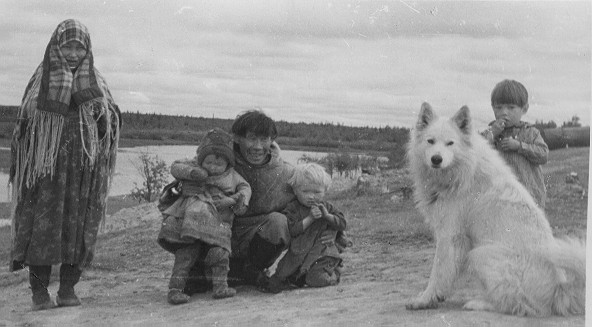
Noho (it means hunter in Nenets language) with his owners when I saw him for the first time. June, 1962, the Poluy River.
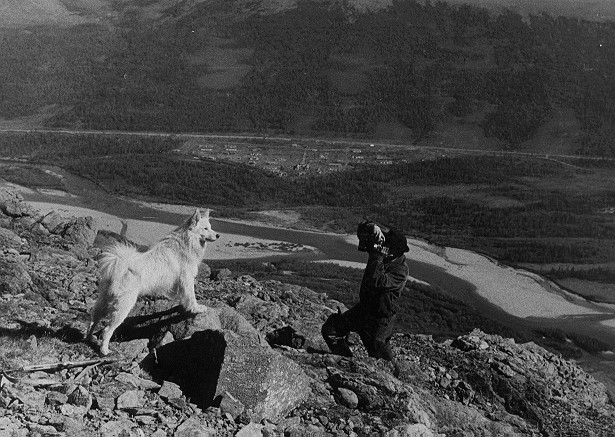
Raiz Plateau, beow the Sob River with an abandoned labor camp where we stationed. On the picture I am taking a picture of Noho.
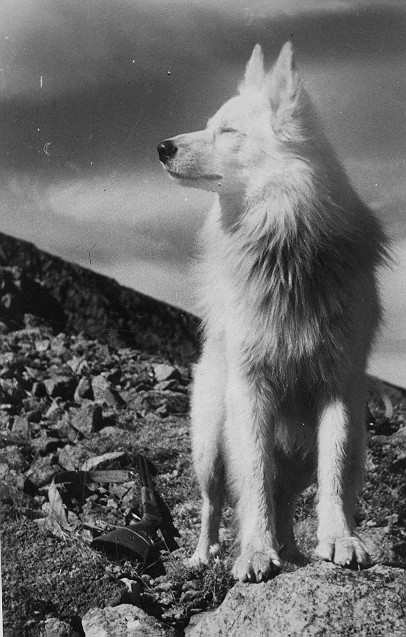
My Samoyed male, Noho. Unfortunately he blinked at the moment.
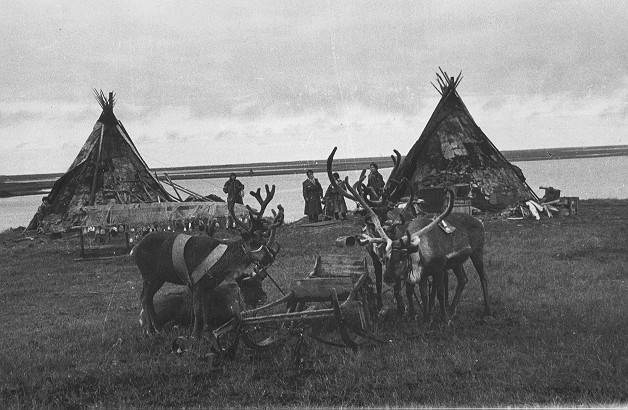
Hanty camp near Kotravozh, the Ob River, August, 1962.
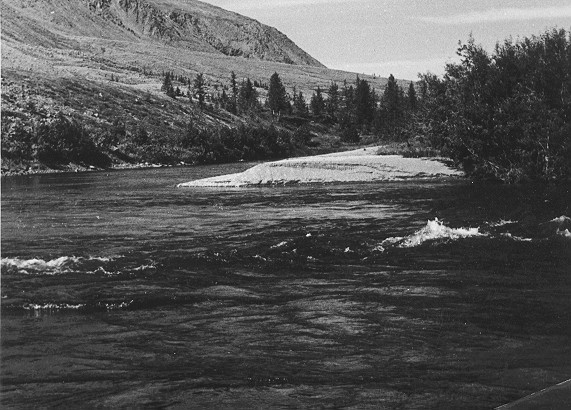
The Sob River.
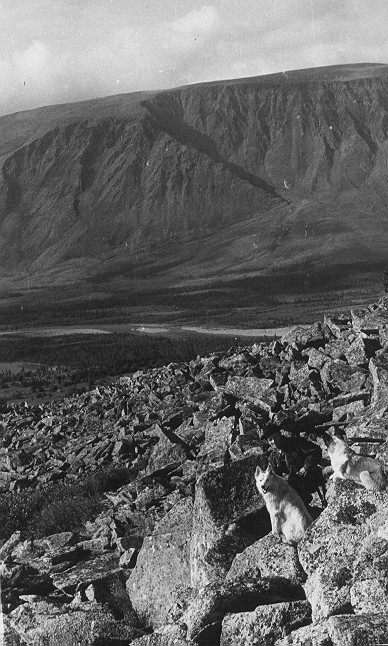
A view at the Raiz Plateau and the Sob River, southern Yamal.
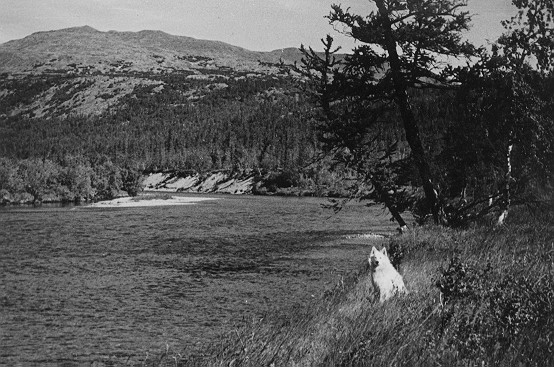
My Noho at the bank of the Poluy River.
